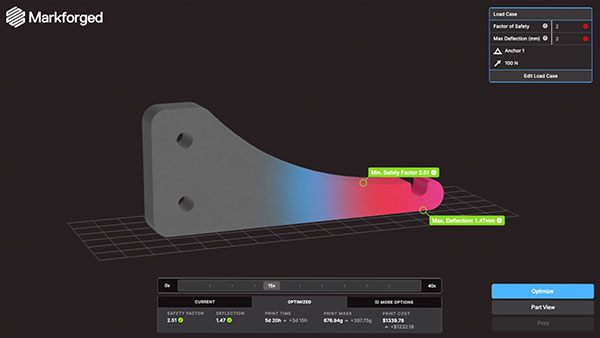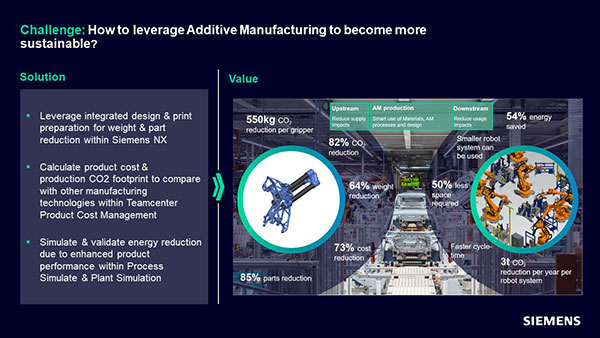
Combining software, hardware and material boosts production efficiency, allowing companies to scale and have products ready to market faster. Image courtesy of Markforged.
February 22, 2023
Digital simulation tools are often used to evaluate and improve numerous processes, including many for manufacturing applications. 3D printing is used in tandem, enabling simulations to be aided with tools and models that bring a virtual design to a physical reality.
3D printing can be applied in many ways, and together, 3D printing along with advanced digital simulation tools are providing a new facet of engineering design that can improve innovation and the final design of so many products in so many industries.
So how are companies leveraging 3D printing along with simulation and modeling tools to expedite manufacturing and bring more efficiency into processes?
First the Part, Then the Process
Ashley Eckhoff is a project manager with the additive manufacturing (AM) team at Siemens Digital Industries Software. He says that over the past few years, there has been increased interest in the 3D printing process, especially from companies that print expensive metal parts.
“Regardless of the additive process used, there are many variables that can affect the final quality of a printed part,” he says. “Anything from scan path to laser power to ambient humidity can have an effect on the end result of a print. This is especially true for companies printing metal parts, which can cost tens of thousands of dollars, so print mistakes are costly. This has driven a rise in the need for AM build simulation where the print job itself is simulated to anticipate areas of issue so that those can be mitigated before thousands of dollars are wasted with a low-quality print.”

Diving deeper beyond the actual part, there’s an opportunity to apply the AM process directly into the traditional manufacturing process. He says this includes not just the print, but also the movement of materials, the printing, removal and post-processing of parts, and the uptime and downtime of equipment in the factory.
“This leads to the need for not just AM print simulation, but full factory process simulation where the entire workings of a factory can be laid out, timed and planned. This type of holistic simulation allows companies to streamline their operations and to identify roadblocks in the manufacturing process,” says Eckhoff.
Eckhoff says it also indicates that companies that are expanding their AM operations can predict the performance of their operation before investing in equipment.
“This means they can answer questions like, ‘If I add three more printers, how much does that increase my production capacity, how much more material will I require every year, and how many more people will I need to man and service that equipment?’” he says.
Factory simulation, according to Eckhoff, provides a company with usable data so that they are running production operations as efficiently and as cost-effectively as possible.
Companies leverage 3D printing for two main uses: rapid prototyping and production. The development of a process follows the development or prototype of the part, says Tim Sissoko, project lead for strategy and transformation with Capgemini Invent.
“Initially, 3D printing was used for rapid prototyping, such as translating the design into a tangible artifact and validating concepts,” he says. “3D printing is efficient and economical since it does not require the development of tooling, mold and casting patterns, and therefore enables designers to iterate quickly. From my observations, AM is now increasingly used for mass production to respond to three main challenges: to produce complex parts like in aerospace and medical, to produce customized goods like prosthetics, and to quickly launch or shift production.”
Sissoko adds that modeling and simulation tools are increasingly used across the product lifecycle, which ultimately increases manufacturing’s efficiency. Models that companies use range from systems architecture models, CAD, finite elements and multidisciplinary design optimization to machining and forging simulation models.
“When using models for simulation, engineers can predict the behavior of products and assess their physical architecture, but can also plan and preview manufacturing operations, detect issues and avoid rework,” he says. “Models are progressively replacing drawings and documents, and these transformations come with the adoption of new tools, collaborative platforms and ways of working.”
Efficiency With 3D Printing and Simulation
Yanis Mansouri is the digital engineering and manufacturing lead with Capgemini Invent. He makes the obvious case for efficiency with 3D printing, which ripples into manufacturing.

“Most parts are made using subtractive manufacturing, which can be very wasteful and expensive,” he says. “More importantly, in some cases, engineers cannot envision how to develop complex parts with subtractive methods without significantly increasing cost or reducing the lifecycle of the parts. Therefore, AM is now considered as an alternative to subtractive manufacturing, with 3D modeling and simulation techniques being key to help engineering in this decision process.”
“It all comes down to efficiency. Process simulation focuses on optimizing processes that are used to manufacture a product whereas 3D printing is used to optimize the design of the product that is being manufactured,” says Zohair Mehkri, the director of digital twin at Flex. “Therefore, combining both unlocks the ability to transform traditional manufacturing drastically. Cost savings, material savings and time savings are just a few of the benefits that come from the combination of these technologies.”
The portability and flexibility of AM stand to bring great gains to manufacturing.
“Beyond the speed to solution and complexity aspects, AM also allows production portability and flexibility from one factory or supplier to another,” says Mansouri. “In the current context, where companies are bringing some of their manufacturing operations back home, AM could be one of the strategies to minimize disruption during the transfer of critical knowledge and operations.”
Mansouri also notes that AM cuts down transportation and inventory costs, leading to part cost reduction and less environmental impact.
Working in Concert
Doug Kenik is director of software product management at Markforged. He says engineers have an “over-engineering” problem regarding AM design.
“Without simulation software, engineers are following the workflow of designing-printing-breaking to test parts, which leads to added costs in time and materials,” says Kenik. “Adding smart simulation into existing 3D printing workflows makes the process more efficient by taking the guesswork out of 3D printing. It gives engineers confidence that their part is strong and uses just the right amount of material, without going through lengthy and repetitive testing cycles.”
Kenik notes that 3D printing continues to draw interest from industries, such as aerospace, automotive and medicine, and simulation will be a key factor to further adoption.
“It gives engineers confidence to push the boundaries of 3D printing and the materials at their disposal,” he says. “A material that is transforming manufacturing is Onyx, which is a micro carbon fiber-filled nylon that offers toughness on its own but can also be reinforced with Markforged’s unique continuous carbon fibers to yield the strength of aluminum. The Onyx material is ready to go from the print bed with a high-quality surface finish that helps expedite the manufacturing process for an end-use part.”

The Onyx material he refers to is displacing applications that traditionally used aluminum or other metals. For example, according to Kenik, Larsen Motorsports, a Florida-based racing company, uses Markforged’s Simulation Software to customize and test part strength for vehicles used in racing before printing a final design.
“Engineers at Larsen recently used Markforged software to customize a 3D-printed steering wheel for a female driver with continuous carbon fiber,” Kenik says. “This is a part that had previously been made from aluminum. With simulation, Larsen could design and test until they had the perfect design to then be 3D printed. This helps to save a day of labor and the cost of failure points for Larsen’s technicians.”
Software Innovation Drives Success
The 3D printing industry is maturing, and it is being driven by smart software and data capturing, says Kenik.
“From the users’ perspective of the software, they can look at the data internally and understand how to handle the next problem based on what was done previously,” he says. “Together with hardware and cloud-based software, teams can build a network of a connected fleet of printers and integrate an automated workflow to quickly validate part performance; thus, this is a method to enhance distributed manufacturing. Overall, we believe software innovation will be a key driver of success for AM in the years ahead.”
More Flex Coverage
More Markforged Coverage
More Siemens Digital Industries Software Coverage
Subscribe to our FREE magazine, FREE email newsletters or both!
About the Author
Jim Romeo is a freelance writer based in Chesapeake, VA. Send e-mail about this article to [email protected].
Follow DE





